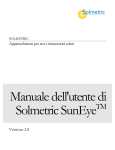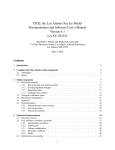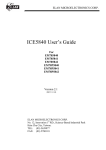Download View/Open - Oregon State University
Transcript
Journal of Geophysical Research Supporting Information for Simulation of the Melt Season using a Resolved Sea Ice Model with Snow Cover and Melt Ponds Eric D. Skyllingstad, Karen M. Shell, Lee Collins College of Earth, Ocean, and Atmospheric Sciences Oregon State University Corvallis, OR 97331 Chris Polashenski Cold Regions Research and Engineering Laboratory U. S. Army Engineer Research and Development Center Hanover, NH 03755 Contents of this file Text S1 Introduction This supplement provides a detailed description of the sea ice model used in the main paper. 1 Text S1. 1. Model Description The model combines a three-dimensional grid structure for ice/brine state variables with a horizontal, two-dimensional snow and ice height field similar to the Scott and Feltham (2010) model. Each grid point is filled with some combination of ice and snow, liquid water/brine, and air depending on the snow/ice and water table heights. For brine-filled ice, the ice internal structure is assumed to follow the mushy layer approach presented in Feltham et al. [2006] where each ice grid volume is divided into fresh water ice with ice volume fraction, ϕ, brine with salinity S if the volume is below the water line, or ice and air. Grid cells on the surface that are completely water-filled and do not have an ice fraction are considered melt pond cells. Snow and ice are treated the same thermodynamically in the model, but have different properties in the radiative transfer scheme. We assume that the void fraction (1- ϕ) of grid cells that are below the water table (or sea level when there is no flooding) are always filled with brine or fresh water. 2. Ice Thermodynamics Different heat budget equations are used in the model depending on the location of the grid cell relative to the water table, the salinity of the brine in the cell, and if the grid cell vertical location contains the top of the snow/ice, his. For grid cells that are below the water table with bulk salinity, Sbulk S(1 ) > 0.02 psu, we use a budget equation derived by Feltham et al. (2006), 2 Tfr S Tfr Sbulk T s L T c L wdarc c l s 2 m Tfr S T z T fr S T t , F Flh Flw kmT I sw z sh z z (1) where (ρc)m represents the combined densities (ρ) and heat capacities (c) for the ice and brine mixture; (ρc)l represents the density and heat capacity for the brine; Tfr S 0.054S oC is the freezing temperature for brine; km is the mixture conductivity; Isw(z) is the shortwave radiation flux calculated from the CICE radiative transfer scheme (see main text); ρs is the ice density; L = 3.34 x 105 J kg-1 is the latent heat of fusion; wdarcy is a velocity representing vertical brine transport (defined in more detail in the main text); Fsh, Flh, and Flw are surface fluxes of sensible heat, latent heat, and infrared radiation, respectively. Positive (upward) fluxes indicate heat loss from the surface. Subscripts s and l denote solid and liquid phases, respectively. The surface fluxes (Fsh, Flh, and Flw) are zero except in the top layer and are divided by the vertical grid spacing, z (we note below that for conditions where the net flux is cooling, the surface flux divergence is calculated over 3 vertical grid points to avoid unrealistic, cold surface temperatures). For simplicity, we model the vertical transport of brine through a Darcy velocity and ignore lateral transport of heat and other brine properties. Melt water in the model is assumed to move instantly across the domain, so that the water table is always at a uniform level, hp, with the minimum water table height set to sea level, hf. When the grid cell below the watertable, the grid cell heat capacity cm and conductivity km are set following Wettlaufer et al. [2000], 3 cm cs cl 1 km ks kl 1 (2) where; c s 1.883 10 6 J m-3K-1; c l 4.185 10 6 J m-3K-1; ks = 2 W m-1 K-1, and kl = 0.5 W m-1 K-1. When the ice void fraction is filled with air, the second terms in the heat capacity and conductivity equations (2) are zero, and these terms are scaled accordingly when the grid cell has a mixture of ice, liquid, and air. Pond cells use only the liquid phase constants. For simplicity, we hold the heat capacity and conductivity constant over each time step, t. For grid points that are mixture of ice and brine, eq. (1) is used to either warm or cool the grid cell temperature. Melting or freezing is then diagnosed by calculating a new grid cell solid fraction using T T fr Sbulk , T (3) which assumes that the mixture of ice and brine are always at the freezing temperature. Thus, as grid cell heat content changes, ice fraction and brine concentration are adjusted to maintain an overall temperature at the freezing point. For grid cells with bulk salinity < 0.02 psu, we discard the salinity and consider the grid cell as a mixture of pure ice and water. In this case, the temperature is held fixed at 0 oC and heating is used to either freeze or melt the ice fraction using 1 T F F F wdarc km T I sw z sh lh lw . t L z z z (4) 4 Each horizontal grid point consists of N equally spaced (z) snow/ice levels plus a top snow/ice layer of height (ztop), which sum to his. When the surface is not covered by a pond, a slightly different ice budget is used in this top cell, where heating is assumed to decrease the total thickness, his, using htop w ztop T F F F kmT I sw z sh lh lw t , wdarc i L z z z (5) where his Nz ztop , and ztop z . The ratio of density accounts for the greater volume per unit mass of ice when converting to thickness change. When ztop is less than 0.01z or ϕ is less than 0.02 then the ice volume contained in the top layer ( ztop ) is added to the ice volume of the Nth grid cell, just below the top, and the number of vertical grid points, N, is reduced to N-1 and ztop z . If the top grid cell is covered by a pond, then (5) is reduced to his w ztop T kmT I sw z t wdarc i L z z . (6) For grid cells above the water table height, decreases in void fraction are added to the grid point melt water budget, mw, defined in equation (3) in the main text. When the net surface flux generates cooling, we average the surface flux divergence over the top 3 vertical grid cells to avoid excessive cooling in the top fractional grid cell. When internal values of ϕ drop below 0.05, then the grid cell and the adjacent grid cell one level above are combined k,k1 0.5 k1 k ; Sk,k1 0.5 Sk Sk1 , (7) 5 and the combine cell temperature is set to either the freezing temperature, if the cells are brine filled, or zero. 3. Pond Thermodynamics Melting of sea ice below and adjacent to ponds is calculated using exchange rates following McPhee et al. (1987), which yield an ice melting velocity, wice, dependent on the pond temperature and ice salinity. We assume that ponds melt at the same rate both vertically and laterally, and we partition the pond temperature change from melting accordingly. Melting of sea ice along the pond edge is calculated by reducing the ice fraction of the adjacent grid cell by wice As w t ice t Vg x (8) where As is grid cell side area and Vg is the grid cell volume. This term is added to Eq. (4) for the adjacent grid cell accounting for increased melt water (ponds are assumed to be fresh). The pond water temperature is governed by, c l T F F F wice L kmT bot I sw z sh lh lw d p x, y z t , (9) where,dp(x,y) is the pond depth (hp-his) at each grid point and heat conduction through the pond bottom into the top ice/snow grid point is governed by (6). Shortwave flux divergence is calculated across the vertical depth of the pond. In this study our primary interest is in modeling the early summer melt season, so ponds are typically ice free. Consequently, we do not model pond ice formation in cases with strong surface cooling, but conserve heat by allowing the pond temperature to temporarily fall below freezing. 6 As indicated in Skyllingstad et al. [2007], wind stirring of pond water typically leads to well-mixed pond water and uniform pond side/bottom melting. Here we use a simple averaging approach to distribute temperature within contiguous pond-covered grid points, d p x, y 1 x1 y1 d p i, j 9 ix1 jy1 1 x1 y1 Tp (x, y) Tp (i, j)d p (i, j) 9d p ix1 jy1 (10) where Tp(x,y) is the depth-averaged pond temperature. Averaging is over a nine-point (3 by 3) stencil and performed for each time step. 4. Heating and Cooling Terms The top layer absorbs all downwelling longwave radiation, and upwelling longwave radiation is calculated with the Stefan-Boltzman equation, RLW Tsfc4 , (9) where = 5.67 x 10-8 W m-2 K-4 and Tsfc is the surface temperature (ice, pond, or snow) simulated by the model at each grid point. Input values of surface air temperature, relative humidity, and wind speed from the ARM site are used to compute sensible and latent heat fluxes from bulk formula, Fsh aC pCHU Ta Tsfc (11) Flh a LvCHU qa qs 7 where a = 1.29 kg m-3 is the air density, Cp = 1004 J K-1 kg-1 is the air heat capacity, CH = 1.5 x 10-3 is the transfer coefficient for heat and moisture, U is the measured wind speed, Ta is the measured atmospheric temperature from 2.0 m height, Lv = 2.5 x 106 J kg-1 is the latent heat of vaporization for water, qs is the saturation specific humidity corresponding to a temperature of Tsrf, and qa is the measured specific humidity from 2.0 m height (see Stull [1988] pg. 262). References Hunke, E. C., and W. H. Lipscomb (2013), CICE: the Los Alamos Sea Ice Model, Documentation and Software User’s Manual, version 5.0. Tech. Rep. LA-CC-06012, Los Alamos National Laboratory, Los Alamos, New Mexico. Notz, D., and M. G. Worster (2006), A 1-D enthalpy model of sea ice, Ann. Glaciol., 44, 123-128. Skyllingstad, E. D., and C. A. Paulson (2007), A numerical study of melt ponds, J. Geophys. Res., 112, C08015, doi:10.1029/2006JC003729. Taylor, P. D., and D. L. Feltham (2004), A model of melt pond evolution on sea ice, J. Geophys. Res.,109, C12007, doi:10.1029/2004JC002361. Stull, R. B. (1988), An Introduction to Boundary Layer Meteorology, 666 pp.,Kluwer Acad., Dordrecht, Netherlands, Wettlaufer, J. S., M. G. Worster, and H. E. Huppert (2000), Solidification of leads: Theory, experiment, and field observations, J. Geophys. Res., 105(C1), 1123-1134. 8 9






























